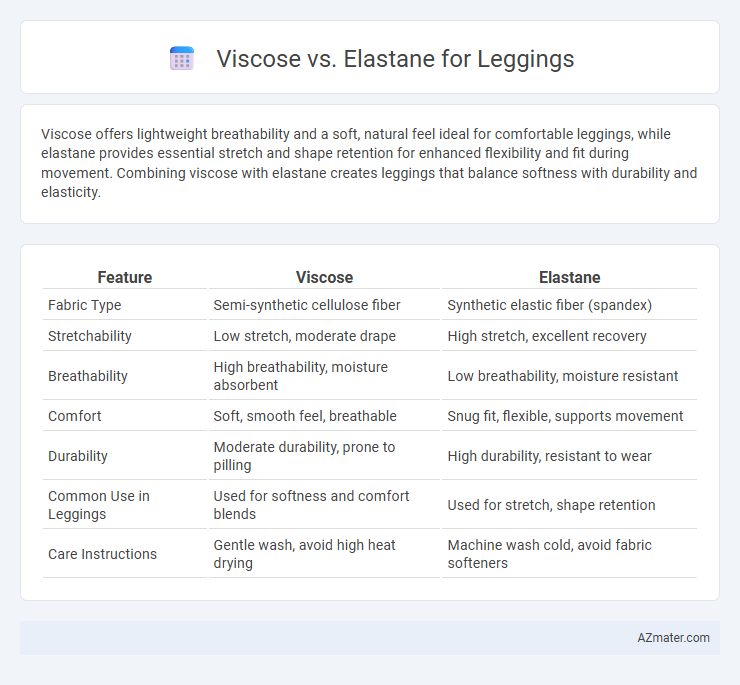Viscose offers lightweight breathability and a soft, natural feel ideal for comfortable leggings, while elastane provides essential stretch and shape retention for enhanced flexibility and fit during movement. Combining viscose with elastane creates leggings that balance softness with durability and elasticity.
Table of Comparison
| Feature | Viscose | Elastane |
|---|---|---|
| Fabric Type | Semi-synthetic cellulose fiber | Synthetic elastic fiber (spandex) |
| Stretchability | Low stretch, moderate drape | High stretch, excellent recovery |
| Breathability | High breathability, moisture absorbent | Low breathability, moisture resistant |
| Comfort | Soft, smooth feel, breathable | Snug fit, flexible, supports movement |
| Durability | Moderate durability, prone to pilling | High durability, resistant to wear |
| Common Use in Leggings | Used for softness and comfort blends | Used for stretch, shape retention |
| Care Instructions | Gentle wash, avoid high heat drying | Machine wash cold, avoid fabric softeners |
Introduction to Viscose and Elastane
Viscose is a semi-synthetic fiber derived from natural cellulose, offering a soft, breathable texture ideal for comfortable leggings that drape well on the body. Elastane, commonly known by the brand name Spandex, is a synthetic fiber prized for its exceptional elasticity, allowing leggings to stretch and retain shape during intense physical activity. Combining viscose with elastane results in leggings that provide both comfort and flexibility, enhancing fit and movement performance.
What is Viscose?
Viscose is a semi-synthetic fiber made from regenerated cellulose derived from wood pulp, offering a soft and breathable fabric ideal for leggings that provide comfort and moisture-wicking properties. Unlike elastane, which adds stretch and flexibility, viscose contributes a smooth, silky texture and enhances breathability, making leggings suitable for warmer climates or light activities. Combining viscose in leggings ensures a natural feel and excellent dye absorption, resulting in vibrant colors and a luxurious finish.
What is Elastane?
Elastane, also known as spandex or Lycra, is a synthetic fiber renowned for its exceptional elasticity, making it ideal for leggings that require stretch and flexibility. It can stretch up to five times its original length, providing superior comfort and shape retention compared to natural fibers. In leggings, elastane is often blended with materials like viscose to combine softness and breathability with excellent stretch and durability.
Key Differences Between Viscose and Elastane
Viscose offers a soft, breathable texture ideal for comfort in leggings, while elastane provides exceptional stretch and shape retention, enhancing flexibility and fit. Viscose is a semi-synthetic fiber derived from cellulose, which absorbs moisture effectively, whereas elastane is a synthetic fiber known for its high elasticity and resistance to wear. The blend of viscose with elastane balances comfort with durability, making it a popular choice for performance and everyday leggings.
Comfort Comparison: Viscose vs. Elastane Leggings
Viscose leggings offer exceptional breathability and a soft, silky texture that enhances overall comfort for all-day wear. Elastane leggings provide superior stretch and shape retention, ensuring a snug fit that moves with the body during physical activities. When comparing comfort, viscose excels in moisture absorption and cooling, while elastane delivers flexibility and support, making each ideal for different comfort needs in leggings.
Breathability and Moisture Management
Viscose leggings boast excellent breathability due to their natural cellulose fibers, promoting airflow and helping to keep the skin cool during workouts. Elastane, while offering superior stretch and shape retention, has lower moisture-wicking properties, often making it less effective at managing sweat and allowing airflow compared to viscose. Combining viscose with elastane blends provides a balanced fabric that enhances comfort through improved breathability and moisture management while maintaining flexibility and durability.
Durability and Stretch Retention
Viscose leggings offer moderate durability but tend to lose shape and elasticity faster than elastane blends, resulting in reduced stretch retention over time. Elastane, known for its exceptional elasticity and resilience, enhances leggings with superior stretch recovery and long-lasting wear even after repeated washing and intense movement. Combining viscose with elastane creates a fabric blend that balances natural breathability with strong durability and consistent stretch performance, ideal for activewear leggings.
Sustainability and Environmental Impact
Viscose leggings, derived from renewable wood pulp, offer biodegradability but involve intensive water and chemical use during production, raising sustainability concerns. Elastane, a synthetic fiber made from non-renewable petroleum, contributes to microplastic pollution and is non-biodegradable, impacting marine ecosystems. Choosing viscose blends with responsible sourcing and closed-loop manufacturing can reduce environmental footprint compared to conventional elastane materials.
Best Uses for Viscose and Elastane in Leggings
Viscose leggings offer exceptional breathability and a soft, silky feel, making them ideal for casual wear and low-impact activities where comfort and moisture absorption are priorities. Elastane, known for its superior stretch and recovery, is best used in high-performance leggings designed for intense workouts, yoga, and athletic activities requiring flexibility and shape retention. Combining viscose with elastane creates leggings that balance comfort with elasticity, suitable for both everyday wear and moderate exercise.
Choosing the Right Legging Fabric for Your Needs
Viscose leggings offer a soft, breathable, and lightweight fabric ideal for everyday comfort and casual wear, while elastane provides exceptional stretch and shape retention, making it perfect for activewear and high-performance leggings. When choosing the right legging fabric, consider your activity level and desired fit: viscose blends enhance drape and softness, whereas elastane-rich fabrics ensure flexibility and durability during workouts. Prioritize elastane content for enhanced elasticity and moisture-wicking properties if you seek leggings tailored for intense physical activity.

Infographic: Viscose vs Elastane for Legging
 azmater.com
azmater.com